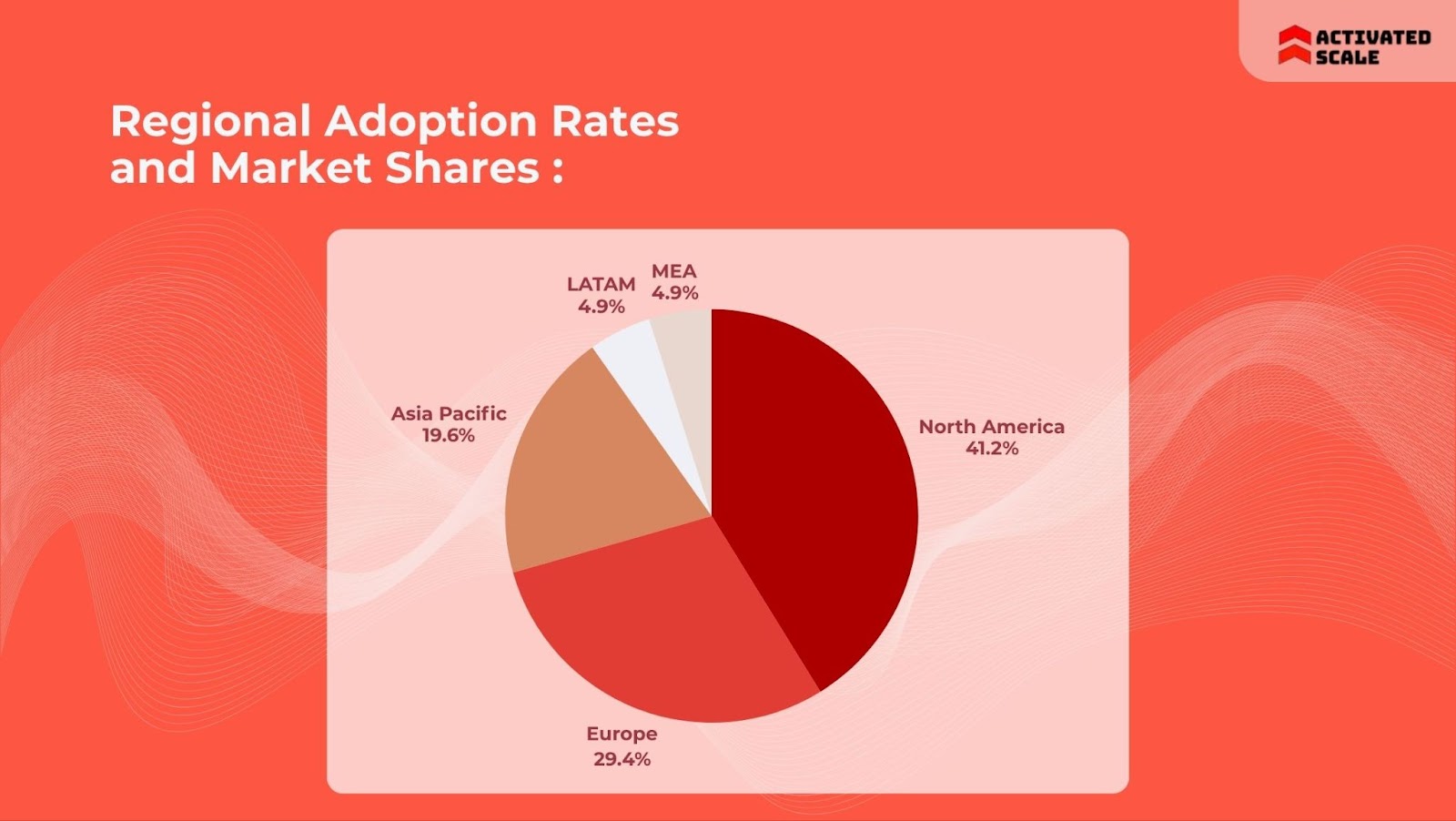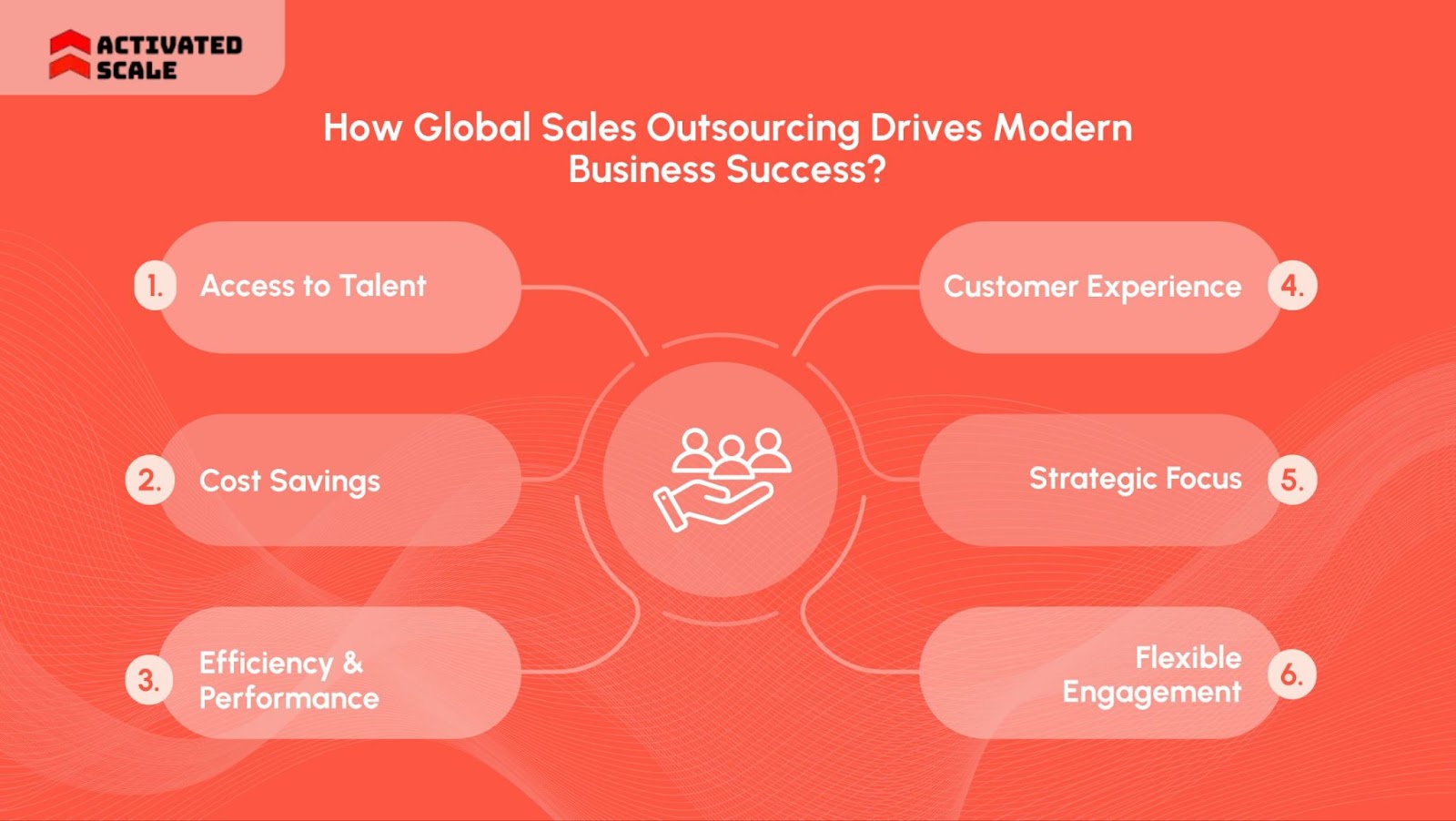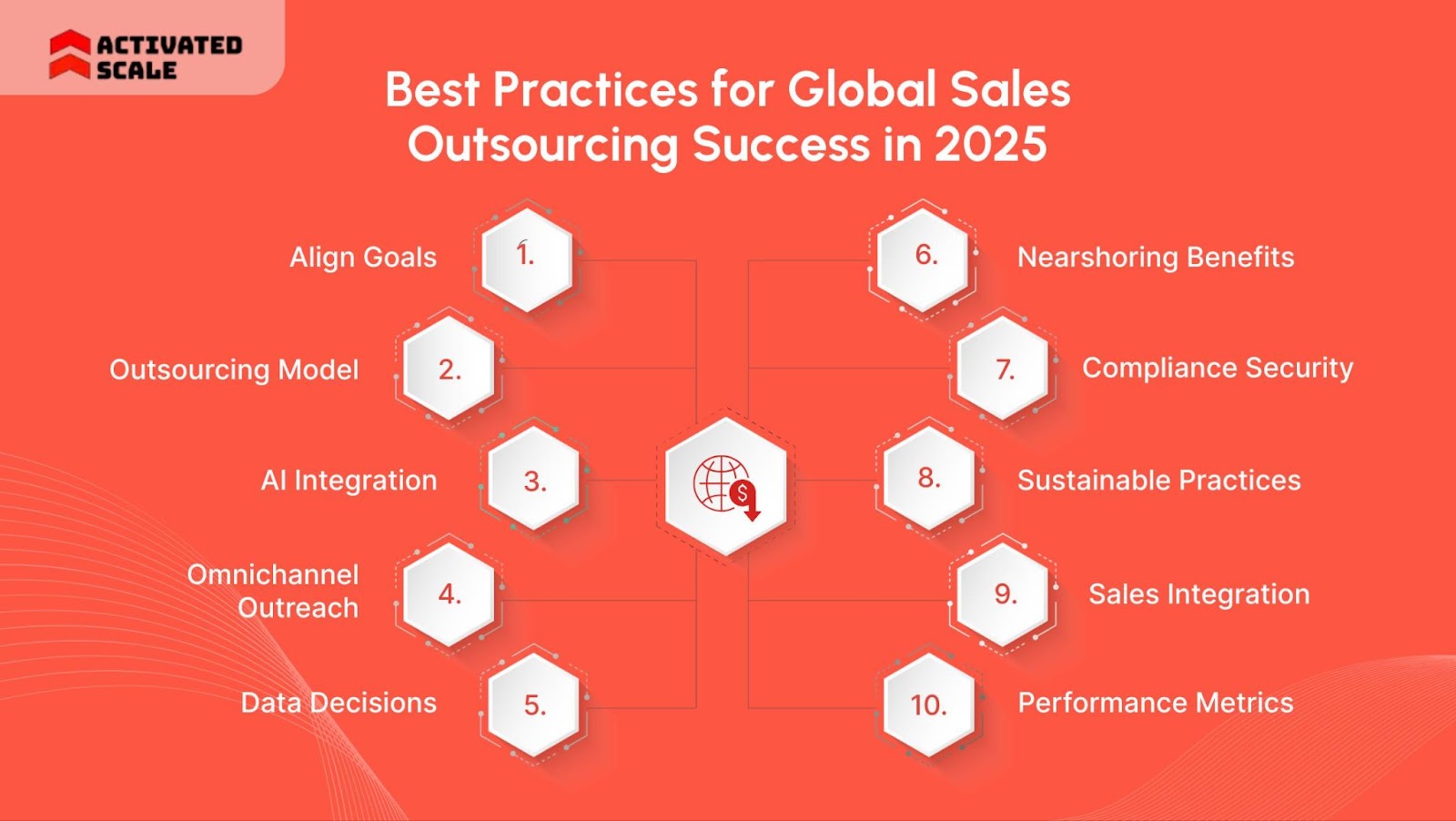Sales outsourcing comes with the promise to scale your sales team, enter new markets, and access world-class expertise, without the overhead of building everything in-house.
The numbers speak for themselves:
The global outsourced sales services market was valued at $2.71 billion in 2024 and is projected to reach $4.21 billion by 2034, growing at a steady CAGR of 4.5%.
For B2B alone, the market is even more staggering: $105.39 billion in 2024, expected to double by 2033.
These figures signal a fundamental shift in how organizations, from fast-scaling startups to established enterprises, approach revenue generation and market expansion.
To stay ahead of the curve, you need to understand the technologies, models, and best practices shaping the future of sales outsourcing.
Key Summary (TL;DR)
- Rapid Market Growth: The global sales outsourcing market is expanding quickly, driven by North America and accelerating in Asia Pacific.
- Enhanced Efficiency Through Technology: AI, automation, and omnichannel strategies are improving lead quality, engagement, and operational efficiency.
- Shift Towards Value and Expertise: Companies are now prioritizing value, flexibility, and expertise over simple cost savings in their outsourcing decisions.
- Future Trends in Sales Outsourcing: Expect deeper tech integration, performance-based models, and higher demands for transparency and security in the coming years.
Market Overview and Growth Projection Of Global Sales Outsourcing
The global sales outsourcing market is experiencing significant growth, driven by the increasing demand for specialized expertise, cost-efficiency, and scalability in sales operations.
Global Market Size and CAGR (2025–2030)
- Zion Market Research projects the global outsourced sales services market to grow from USD 2.71 billion in 2024 to USD 4.21 billion by 2034, at a compound annual growth rate (CAGR) of 4.5% from 2025 to 2034.
- Grand View Research estimates the global sales and marketing business process outsourcing market size at USD 28.65 billion in 2022, with projections to reach USD 57.46 billion by 2030, growing at a CAGR of 9.4% from 2023 to 2030.
Regional Adoption Rates and Market Shares

The global sales outsourcing market is on a steady growth trajectory, with North America leading in adoption and Asia Pacific showing the fastest acceleration.
1. North America
- Leads the global market; accounts for 42% of global outsourced sales spending.
- Dominates B2B sales outsourcing with a 40% share.
- The US market is projected to grow at 8.5% annually (2021–2026).
2. Europe
- Holds a 30% share of B2B sales outsourcing revenue.
- Strong adoption in technology, finance, and manufacturing sectors.
3. Asia Pacific
- Fastest-growing region, with a 9% CAGR in B2B sales outsourcing.
- China’s enterprise services market has grown 22% per annum over the last 5 years.
- India’s sales outsourcing market is growing at 26% annually.
- Accounts for 20% of B2B market revenue.
4. Latin America & Middle East/Africa
- Each region holds a 5% share of B2B sales outsourcing.
- Growth is driven by internationalization and demand for flexible sales models.
Summary Table: Regional Market Shares (2023–2025)
Emerging Trends in Global Sales Outsourcing
In this section, we’ll explore how emerging technologies like AI, automation, and cloud-based platforms are transforming global sales outsourcing. We’ll also discuss the growing importance of data security, compliance, and the integration of sales and marketing tools.
1. AI and Automation in Sales Outsourcing
Over 70% of sales teams now use AI and automation to qualify leads, personalize outreach, and optimize sales cycles, resulting in faster ramp-up and higher close rates.
- Transforming Lead Generation
AI-powered tools analyze vast datasets to identify high-potential prospects with remarkable accuracy. Predictive lead scoring, intent data, and behavioral analytics enable outsourced sales teams to focus on leads most likely to convert, significantly improving win rates and reducing time spent on unqualified prospects.
- Revolutionizing Sales Analytics
Automation platforms continuously track and analyze sales activities, pipeline health, and customer interactions. This real-time intelligence allows for data-driven decision-making, immediate course corrections, and transparent reporting—critical for both clients and outsourcing partners seeking measurable ROI.
- CRM Integration and Workflow Automation
Modern CRM systems, enhanced with AI, automate routine tasks such as data entry, follow-up scheduling, and opportunity tracking. Seamless integration between outsourced teams and client CRMs ensures data consistency, accelerates sales cycles, and enhances collaboration across distributed teams.
- Predictive Analytics and Chatbots for Engagement
80% of B2B buyers expect a personalized experience, and companies that deliver see up to 41% higher click-through rates. Predictive analytics anticipate customer needs, recommend next-best actions, and personalize outreach at scale. AI-driven chatbots handle initial inquiries, qualify leads, and provide instant responses, delivering 24/7 engagement and freeing human reps for higher-value conversations.
2. Data Security and Compliance
As sales outsourcing expands globally, data security and regulatory compliance have become non-negotiable priorities.
- Rising Importance of Cybersecurity
With sensitive customer and business data flowing between organizations and outsourced partners, robust cybersecurity measures are essential. The risk of data breaches, phishing, and ransomware attacks has prompted stricter protocols and continuous monitoring.
- Evolving Regulatory Requirements
Outsourced sales operations must comply with a growing array of regulations: GDPR in Europe, CCPA in California, and sector-specific rules in finance and healthcare. Non-compliance can result in severe penalties and reputational damage.
- Best Practices for Data Protection
Leading providers implement end-to-end encryption, multi-factor authentication, and regular security audits. Data minimization, role-based access controls, and secure cloud storage are standard. Many firms now require third-party certifications (e.g., ISO 27001, SOC 2) to demonstrate their commitment to data protection.
- Integration of Sales and Marketing Platforms
The integration of sales and marketing platforms is driving a new era of unified, omnichannel customer engagement.
- Omnichannel and Unified Strategies
Sales teams using multiple channels like email, phone, Land inkedIn see up to 300% higher conversion rates. Quick response to inbound leads (within an hour) increases conversion likelihood by 7x. This enables seamless handoffs, consistent messaging, and personalized experiences across email, phone, social media, and live chat, meeting customers wherever they are in the buying journey.
- Cloud-Based Collaboration for Distributed Teams:
Cloud-based CRMs, project management, and communication tools (like Slack, Microsoft Teams, and Zoom) empower geographically dispersed sales teams to collaborate in real time. These platforms facilitate knowledge sharing, rapid onboarding, and transparent performance tracking, ensuring that outsourced sales operations remain agile and aligned with client goals.
- Data-Driven Alignment:
Shared dashboards and unified analytics break down silos between sales and marketing, enabling both functions to work from a single source of truth. This alignment drives better lead nurturing, higher conversion rates, and more effective campaign optimization.
Also Read: Top 10 Best CRM Software for Small Businesses in 2025
How Global Sales Outsourcing Drives Modern Business Success

Global sales outsourcing helps businesses grow by providing quick access to expert sales talent. It reduces costs and improves sales performance. This approach also allows companies to stay flexible and respond faster to market changes.
1. Expanded Access to Talent and Expertise
Outsourcing connects companies to a global pool of skilled professionals, overcoming local talent shortages, a challenge reported by 74% of employers in 2025. This access is especially critical as technology evolves and specialized sales skills become harder to find.
2. Cost Savings and Spend Optimization
While cost reduction remains important, it’s now just one of several key drivers. 70% of businesses once cited cost as the main reason to outsource; today, only 34% do, as companies increasingly value efficiency and scalability. Still, outsourcing can deliver operational cost savings of 30–50% over in-house teams, freeing resources for growth and innovation.
3. Improved Efficiency and Performance
33% of businesses report improved quality and performance through outsourcing. Outsourced partners bring proven processes, advanced technology, and a focus on measurable results, allowing companies to streamline operations and respond faster to changing market demands.
4. Enhanced Customer Experience and Agility
With rising customer expectations, 35% of organizations now outsource to meet increasing demands for speed and service. Outsourcing enables rapid scaling, 24/7 support, and access to multilingual teams, key for global expansion and customer satisfaction.
5. Strategic Focus and Innovation
Outsourcing routine or specialized sales functions lets internal teams focus on core business initiatives. 42% of businesses cite improved access to talent as a top benefit, while 33% highlight the adoption of global delivery models that drive innovation and flexibility.
6. Flexible Engagement and Global Reach
Modern outsourcing offers flexible, results-driven contracts and the ability to scale teams up or down quickly. This agility is vital for responding to seasonal spikes, new product launches, or shifts in global markets.
Best Practices for Global Sales Outsourcing Success in 2025

Here are the top best practices for global sales outsourcing success in 2025. These proven strategies help businesses maximize ROI, improve sales results, and reduce risks when working with external partners. Follow these guidelines to build a high-performing outsourced sales operation.
1. Align on Clear Goals and Success Metrics
Before engaging any partner, define your sales development objectives, KPIs, and what success looks like. Align internal stakeholders on these priorities to ensure everyone is working toward the same outcomes.
2. Choose the Right Outsourcing Model
Adopt a hybrid approach, keep strategic roles in-house (like closers and account executives) while outsourcing top-of-funnel tasks (lead generation, SDR work) to specialized providers. This model gives you flexibility, faster ramp-ups, and broader market coverage.
For startups and growing companies, partnering with a platform like Activated Scale offers flexibility to scale your sales team up or down as needed, access to vetted sales professionals, and reduced hiring risk.
3. Prioritize AI and Automation Integration
Work with partners who use AI for lead scoring, outreach automation, and analytics. Sales teams using AI lead to up to 50% higher productivity and higher conversion rates.
4. Embrace Omnichannel and Personalized Outreach
Use at least three outreach channels (email, phone, LinkedIn, etc.) for 287% higher engagement rates. Ensure your outsourced team can deliver personalized messaging, as this drives a 32% higher reply rate.
5. Use Data-Driven Decision Making
Insist on transparent, real-time reporting. Track metrics like lead-to-meeting rate, pipeline velocity, and CRM data accuracy. Teams using analytics tools see measurable improvements in lead qualification and close rates.
6. Consider Nearshoring for Cultural Alignment
Nearshoring (outsourcing to nearby regions) offers better quality control, real-time collaboration, and bilingual capabilities. 92% of U.S. companies report improved quality with nearshore teams.
7. Ensure Solid Compliance and Security
Verify that your partner meets global data protection standards (GDPR, CCPA, ISO certifications). This is essential for safeguarding sensitive customer data and maintaining regulatory compliance.
8. Audit for Ethical and Sustainable Practices
By 2025, 72% of companies require partners to meet sustainability benchmarks. Assess your provider’s environmental, labor, and community impact policies to future-proof your brand reputation.
9. Foster Seamless Sales and Marketing Integration
Choose partners who can sync with your CRM and marketing automation tools, ensuring unified data and consistent messaging across all channels.
10. Demand Transparent Performance Guardrails
Set non-negotiable KPIs (e.g., minimum lead-to-meeting rates, multi-channel contact attempts, CRM hygiene standards). Require weekly or monthly performance reports to ensure accountability and continuous improvement.
Also Read: Top 10 Sales Prospecting Tools to Supercharge Your B2B Pipeline in 2025
Conclusion
The next decade will redefine global sales outsourcing, shifting it from a cost-cutting tactic to a strategic engine for growth, innovation, and market expansion. By 2035, advanced technologies like AI, automation, and predictive analytics will be deeply embedded in outsourced sales operations.
These tools will enable hyper-personalized outreach, smarter lead targeting, and real-time performance optimization.
To stay ahead of the curve, you need a partner who can deliver agility, innovation, and measurable results.
If you're ready to future-proof your sales strategy and unlock scalable growth, schedule a strategy call with Activated Scale today. Discover how their solutions can help you lead in the next era of global sales outsourcing.
FAQs About Global Sales Outsourcing Trends
- What is sales outsourcing?
Sales outsourcing involves delegating a company's sales functions to third-party agencies, allowing businesses to focus on core activities while using external expertise.
- How does technology impact global sales outsourcing?
Technology enhances efficiency by integrating tools like AI, automation, and CRM systems, which streamline lead generation, customer engagement, and data analysis in outsourced sales operations.
- What are the main benefits of outsourcing sales?
Benefits include cost savings, access to specialized talent, scalability, faster market entry, and the ability to focus on core business functions.
- Which industries are most likely to benefit from sales outsourcing?
Industries such as IT, SaaS, healthcare, finance, and retail are leading adopters due to their need for cost-effective, scalable sales operations and specialized expertise.
- What challenges should companies consider when outsourcing sales?
Common challenges include maintaining brand consistency, quality control, communication barriers, and ensuring cultural alignment with outsourcing partners.
The Ultimate Guide to Hiring a Salesperson!
Get the step-by-step guide to hiring, onboarding, and ensuring success!
_edi.png)




